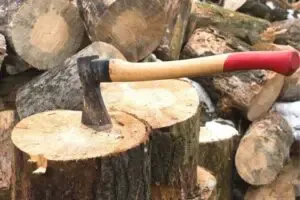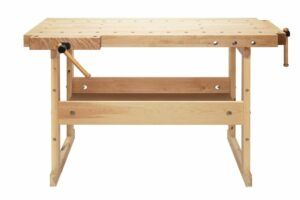
You are looking forward to a tool for splitting wood? But wondering between choosing a splitting axe and splitting maul.
The features of splitting axes and mauls have several things in common.
But in reality, they are different tools and should be treated like that. Getting the right choice for the job can make it more efficient and less exhausting.
This splitting axe vs maul details comparison will show you which tool is a better choice for specific situations.
Read on and avoid a rage of frustration when choosing the wrong tool.
Table of Contents
Splitting Axes

Splitting axes are a special axe variant designed for splitting the logs along their wood grain.
Compared to normal axes, their bits have a more wedge-like shape. It allows the axe head to rend the fibers when stuck into the wood.
Many models still use wooden handle, like ash or hickory. But manufacturers also start using synthetic materials like fiberglass composite. Composite handles are even lighter and more durable than wood handles.
The handles of splitting axes are longer than those of hatchets. They can be anywhere between 14 inches to 36 inches. Most of their weights lie on the metal head, which mostly weighs between 3 and 6 pounds.
- Lightweight and compact
- More affordable
- Suitable for small or softwood chunks
- Easier to swing
- More accurate for strikes
- Not enough power for large and hardwood pieces
- Easier to get stuck
- Need to more strikes to complete split
Splitting Mauls

The splitting mauls look like a splitting axe. But the maul head is much bigger and wider. They come with a longer handle and weigh at least 6 pounds, more than most axes.
Another huge difference is the backside of these mauls. Their flat surface can act like a sledgehammer to drive a wedge through the wood.
Loggers use these tools to split large chunks of wood when splitting machines aren’t available. They offer more power than splitting axes.
Also, you need more energy to swing a splitting maul so you will get more quickly tired.
- Suitable for large and hard logs
- Smaller risk of getting stuck
- Work great with wedges
- Offers greater leverage
- More convenient than log splitters
- Don’t need to sharpen the regular blade
- Heavy and bulky, more difficult to swing
- Quite expensive
- Result in more fatigue
- Less accurate than splitting axe
Difference Between Splitting Axe And Splitting Maul

Head Design
In general, the tapered heads of splitting axes are thinner and smaller with sharper blades so they can split and cut wood.
On the other hand, mauls have bulkier heads with a different wedge-like profile. It is wider and has more beveled corners. The cutting edges are also blunter with a wider wedge providing efficiency when splitting large wood.
Additionally, we usually only need to pay attention to one side of an axe’s head. It’s where the cutting blade is located.
But on a maul, the other side of the head has its use too. This sledgehammer-like side can come in handy when you need to split large logs.
When dealing with big logs, you often need a splitting wedge. The bulky blunt side of a maul head lets you nail down that wedge more easily. If you only have an axe, you may want to bring out a hammer.
Weight
When a lightweight tool is your top concern, a splitting axe should be more appealing. Even with similar construction, the more compact size makes axes a lighter choice than mauls.
Splitting axes weigh around 3 – 6 pounds. Even their biggest models rarely go beyond the 6-pound mark.
Meanwhile, most mauls have a weight between 6 and 8 pounds. Most of this extra weight comes from their bigger metal heads.
Handle And Material
Generally, mauls have a longer handle than splitting axe. They need it to support and swing their bulky heads.
That said, the actual handle length depends on the specific model. This range varies widely in both axes and mauls.
While most mauls have a suitable handle of around 32 inches, it’s also common to see models with a 14 – 36 inches handle.
Likewise, the handles of most splitting axes are shorter than mauls. But heavy-duty models with a 36-inch handle are available as well.
On the other hand, manufacturers use a wider variety of materials to make the handles of these tools.
Hardwoods like hickory are the traditional choice for both axes and mauls. They are less expensive, lightweight, and can absorb a great amount of shock.
The downside is wood handles tend to break more easily. Most handles of splitting axe are made from wood or composite materials.
While steel handles are very durable, they don’t absorb much shock. Composite materials like fiberglass can stop some vibration, but they are more fragile.
Overall, there isn’t any big difference when it comes to handles and materials. For the most part, they are determined by the size of the tool and personal preference.

Swing Action
The sizes and weights mentioned above result in different ways to handle splitting axes and mauls.
Most people should have no trouble swinging an axe. It requires less strength to hold and swing an axe into pieces of wood. Strikes can occur at a faster speed with less effort from the operator.
You also can maneuver a splitting axe in different positions and angles. It’s possible to split a log at your eye level or on the ground.
The story is different for a typical maul. Your body must involve more muscles and strength to swing a maul. You can’t strike in a fast sequence. Even a beefy lumberjack is no exception.
It’s usually impossible for a swing to occur outside of your body’s center plane. It is the best posture for your muscles to contain and guide a heavy maul.
Strike a maul at an angle is a real challenge. This limitation makes mauls less versatile in many circumstances.
Working With Splitting Wedges
Wedges are a common tool for loggers or when firewood is your home’s primary heat source. They are important complements even if you already own the best maul or axe on the market.
For the hardest woods, a good wedge makes the process much easier. They can provide additional power and reduce the effort and time needed.
But not every splitting axe or maul can take advantage of this tool. Only the sledgehammer-like side of mauls is designed specifically for this task.
Its board and heavy surface make a perfect tool for striking a wedge. Turn a maul around, and you can drive a metal wedge through wood with ease.
You can try to strike a wedge with an axe, but it’s usually a bad choice. Manufacturers don’t have this use in mind when designing them.
Their constructions may not be able to withstand the powerful impact produced by such strikes. The handle may become loose, cracked, or even broken.
Many manufacturers like Gränsfors explicitly advise against this. They only recommend mauls for hitting a wedge.
Accuracy
The smaller and thinner blades of the splitting axe can deliver strikes with greater precision than mauls. The axes travel in shorter distances, allowing you to aim and land them in the wood better.
A maul takes a longer time to hit the wood. Its heavyweight makes it harder to strike where you need it.
It creates greater momentum. And when the motion goes wrong, it’s harder to stop or adjust it. The problem gets worse when you get tired or lose focus, which happens more often with mauls.
After all, a splitting axe will give you a better chance to make accurate strikes.
Impact Power
It’s obvious that the mauls can produce more impact in each swing. They are heavier and can hold more energy when lifted.
You transfer this energy into the wood to crack it when finishing the swing.
You often need the level of power mauls provided to split large or hardwood logs.
Big splitting wedges will barely move if you hit them with inadequate tools like a smaller axe.
The longer handle of mauls also plays a big role here.
It extends the reach of your arms and creates more leverage for the swings. One-strike splits are totally possible with them.

Ease Of Use
Splitting wood is an exhausting task. And you can use a splitting axe for a longer period of time than a maul.
A maul can deliver a bigger impact. But in return, it also asks for more energy from the splitter. Some people don’t need enough strength to handle a maul.
The constant energy required in using a maul makes us tired faster.
You may need to make more strikes with a splitting axe for the same job. But each swing finishes faster and results in less fatigue.
A splitting axe has its own learning curve. But switching to a maul demands even more care and attention.
It’s common for the blunt blade of a maul to bounce back at the end of a swing. This often occurs at the first strikes into hardwood.
The logs don’t crack open but transfer the impact back to your body through the handle. This impact shock can make you lose control of the maul.
Applications
These splitting tools are both popular among the logging and woodworking communities.
They have some overlapping areas where both tools can get the job done. But there are also specific applications, one of them is a better choice.
For small rounds of wood, think about a splitting axe first. They also excel at splitting around the edges of the wood or cut wood.
Mauls are a more efficient tool for large rounds. They also open the opportunity to use a wedge. This combo can help you deal with most gnarly logs of tough wood fibers.
Cost
The prices of these tools depend on their size, material, and brand.
Splitting axes and mauls of premium brands like Gransfors are the most expensive. They use better materials and more ergonomic designs. You can find more affordable models from names like Fiskars.
Most manufacturers include both axes and mauls in their catalogs. Those models have many things in common when it comes to design and build-quality.
The price of those products increases with the size of the tool. Each catalog usually starts with some low-cost smaller axes. At the end of the lineup are more expensive mauls and heavy-duty axes.
You would want to pay attention to the quality of the materials too. An axe may cost more than a more substantial maul because it has better metal and forging technology for the head.
Nevertheless, splitting axes provide more affordable price options than mauls when all things are equal.
Conclusion
They look quite similar and both can capacity into splitting wood. But splitting axes and mauls aren’t the exact same thing.
Mauls are among the strongest manual tools you can have. They create powerful impacts required to crack open stubborn wood.
They can be massive wood logs or bolts of hardwood like oak.
Electric and gas-powered log splitters can deliver more output. But they’re a huge investment and can be troublesome to handle.
That said, splitting axes have their place too. Manufacturers cater axes to those who need to handle light and medium jobs.
The decision boils down to your workload and the type of wood. Your personal preference and strength can also sway the choice.
All in all, consider a splitting axe when you:
- Need a lighter tool
- Want to make quick strikes
- Handle soft and small logs
- Don’t have the stamina needed in long splitting sessions
- Have a limited budget
Meanwhile, a maul can be a good choice if you:
- Heavy-duty jobs process large logs
- Want to split large pieces in fewer strikes
- Don’t mind the price
- Don’t want to use log splitters.
If you still can’t come to a decision after this comparison, a splitting axe can be a great starting tool.






